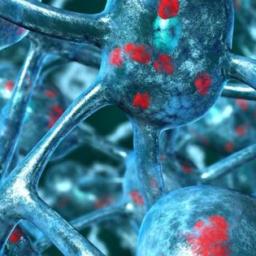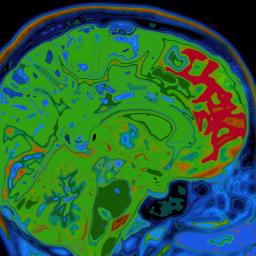A brain region called the insular cortex may drive smoking addiction, say scientists who found stroke survivors with damage to this part of the brain more easily kicked the habit.
Story
UCLA researchers' clot-retrieval device improves chances for stroke victimsSimilar News
 |
 |
Using electricity to stimulate parts of the brain may ease the symptoms of motion sickness, scientists say.
|
 |
by Rob Beschizza from on (#KAJR)
Michael Grothaus quit sugar, soon regretted it, but came through after a week or so. Read the rest
|
 |
from on (#K3C6)
The day before her husband died, Heidi Wilk saw a big rainbow from his hospital room window at Sunnybrook. She took it as a soft sign of peace and tranquility, and the next morning she cradled him as his heart thumped to a halt and the breath left his body.
|
 |
from on (#K2W1)
The day before her husband died, Heidi Wilk saw a big rainbow from his hospital room window at Sunnybrook. She took it as a soft sign of peace and tranquility, and the next morning she cradled him as his heart thumped to a halt and the breath left his body.
|
 |
from on (#JXPM)
Author wrote about bizarre neurological conditions in books like ‘The Man Who Mistook His Wife for a Hat.’
|
 |
 |
Devs try for frantic in-car fix as cyclist stands still A cyclist riding a fixed-gear bike claims to have brought a Google robo-car to a standstill.…
|
 |
Brain cells in Parkinson's disease exhaust themselves and die prematurely, burning out like an "overheating motor", an early study suggests.
|
 |
by Mark Frauenfelder from on (#JHB8)
Gareth Branwyn is blogging for Make, and I've been enjoying his posts. Take a look at this golf ball inside a cage that's hogged out of a single piece of wood.
|
 |
 |
Surgeons in London use lasers to diagnose abnormal tissue during an operation to remove a brain tumour.
|
 |
by Jeremy Hsu from IEEE Spectrum on (#JGRZ)
The AI Impacts project estimates computer hardware could match the human brain in four to seven years
|
by Denise Hassanzade Ajiri for Tehran Bureau from World news | The Guardian on (#JFEB)
Custom documents show that Iran spent subsidised dollars on luxury goods as the ministry of health scrambled for suppliesIn 2012, the United States and European Union introduced new financial and energy sanctions designed in part to curb Iran’s oil exports. The US threatened foreign financial institutions dealing with Iran’s Central Bank, making it hard for Iranian companies to acquire the dollars needed to buy imports.
 |
 |
 |
There is a postcode lottery for an essential surgical treatment for Parkinson's depending on which side of Scotland you live, a charity says.
|
by Editorial from on (#JAYZ)
A stock market bubble and bust that was made in China might have stayed there – had the west not got other reasons to be fearfulPotential disruption to the iron ore trade; the sudden exposure of the South African rand; the incompatibility of Xi Jinping’s anti-corruption drive with that Wild East entrepreneurial spirit which has powered decades of Chinese growth. Watching panic spread from Shanghai and Shenzhen to London and New York, western analysts grabbed for straws of understanding in unfamiliar fields, reflecting not only a professional need to look as if they know what’s going on, but a psychological yearning to impose order on a wild, mercurial swing in the mood. There may be no single reason why August 2015 proved the moment for the world’s investors to take collective fright about the People’s Republic. What there is however, lurking under all the anxiety, is a single question for governments everywhere. Namely, what’s left in the locker?Like a swaggering pre-crash financier, Beijing had grown to resemble a Master of the Universe. What it said more or less went; even the great crisis of 2008 caused only modest and impermanent departure from the course that it had set. But in recent months, the regime has been having to do ever more to achieve ever less. After inflating an extraordinary stock bubble, by enticing people of modest means into the market, the Communist rulers became visibly terrified of a burst. Restrictions were imposed on shares being sold off, while public bodies were sent on a buying spree. Instead of soothing nerves, these measures only stirred new concerns about why they had been necessary at all. Beijing’s grip on events loosened again in the eyes of the world after it allowed the yuan to slide over the last fortnight. This might have been explained as a pragmatic adjustment to a slowdown at home after years in which a rising currency had eroded competitiveness overseas. Instead, there was spin suggesting that the move was all part of a well-laid plan, which succeeded only in alerting the world to the rate at which China had been burning through its vast reserves. That created such panic that further resources soon had to be spent on putting a floor under the slide. Continue reading...
by Mo Costandi from Science | The Guardian on (#J4FK)
New research suggests that body posture during sleep may affect the efficiency of the brain’s self-cleaning processThe human brain can be compared to something like a big, bustling city. It has workers, the neurons and glial cells which co-operate with each other to process information; it has offices, the clusters of cells that work together to achieve specific tasks; it has highways, the fibre bundles that transfer information across long distances; and it has centralised hubs, the densely interconnected nodes that integrate information from its distributed networks.Like any big city, the brain also produces large amounts of waste products, which have to be cleared away so that they do not clog up its delicate moving parts. Until very recently, though, we knew very little about how this happens. The brain’s waste disposal system has now been identified. We now know that it operates while we sleep at night, just like the waste collectors in most big cities, and the latest research suggests that certain sleeping positions might make it more efficient. Continue reading...
by David Cox from Science | The Guardian on (#J279)
With deaths from antibiotic resistance far outstripping even those of epidemics such as Ebola, scientists are desperate to discover new classes of antibioticsOff the coast of California, nearly 20,000 feet below the surface of the Pacific Ocean, scientists from the San Diego Institute of Oceaneography are collecting samples of marine life from the ocean floor. At first glance, these small clumps of sediment may appear nothing special, but the micro-organisms which lie within may one day provide an answer to one of the most urgent issues in modern healthcare: the global antibiotic resistance pandemic.To put the scale of the problem in perspective: the Ebola epidemic in West Africa captured the headlines in 2014, and in total the virus accounted for just over 11,000 fatalities, making it as the most devastating outbreak of the virus in history. Current estimates place the annual number of deaths from antibiotic resistant bacteria at around 700,000 worldwide. Unless things change this figure is predicted to rise to 10 million by 2050, with growing numbers of bacteria already fully resistant to every clinical antibiotic available. Continue reading...
 |
from on (#J048)
Industry-backed questionnaire played key role in approval of female sex pill
|
by Guardian Staff from World news | The Guardian on (#HZ8E)
Carter, 91, reveals that doctors have detected ‘four spots’ of melanoma on his brain after liver cancer surgery. Carter held a press conference at the Carter Center in Atlanta to announce the diagnosis, saying he will have four treatments scheduled in three-week intervals – the first of which starts on Thursday Continue reading...
 |
from on (#HYYD)
Former President Jimmy Carter announced Thursday that he will begin radiation treatment on cancer that is on multiple spots on his brain.
|
by Tom McCarthy in New York from World news | The Guardian on (#HYWN)
Former US president says he will be undergoing radiation treatment to fight melanoma and that he has ‘complete confidence’ in medical teamJimmy Carter’s melanoma, a form of skin cancer, has been discovered in four places on his brain and is likely to “show up other places in my bodyâ€, the former US president said on Thursday.Carter told a news conference he would be undergoing radiation treatments and injections to fight the cancer, which was discovered after he underwent surgery to remove a growth on his liver, where melanoma also had been discovered, he said. Continue reading...
 |
from on (#HYYF)
Jimmy Carter says cancer is on his brain, will undergo 1st radiation treatment
|
 |
by Cathleen O'Grady from Ars Technica - All content on (#HYV7)
Whistled Turkish is processed equally by both sides of the brain.
|
 |
by Katie M. Palmer from on (#HZ2S)
A group at Ohio State University says they've made the most complete replica of a 5-week-old human brain from stem cells. You shouldn't know about it yet. The post That Human Brain in a Dish? Not Ready for Prime Time appeared first on WIRED.
|
 |
People working more than 40 hours a week are more likely to have a stroke, a study suggests.
|
by Peter Beaumont in Jerusalem from World news | The Guardian on (#HW1V)
Detention of Mohammed Allan temporarily suspended after MRI scan shows brain injury following hunger strike over detention policyDoctors treating a Palestinian lawyer who has been on hunger strike for 65 days in an Israeli prison say he suffered brain damage, prompting Israel’s supreme court to rule it was temporarily suspending his detention.An MRI scan was ordered for Mohammed Allan after a lawyer for the Israeli state told a supreme court hearing that Allan would be released immediately if he had irreversible brain damage. Continue reading...
by Jessica Glenza in New York from Science | The Guardian on (#HVHK)
Findings that highlight how brain’s ‘plasticity’ allows congenitally blind and sighted children to adapt to sensory experiences could inform future treatmentsParts of the brain once thought to be primarily devoted to processing vision can be recruited by blind children as young as five to process speech, a study has found.The work could have implications for neurologists’ understanding of “plasticityâ€, or how the brain adapts to experience. Continue reading...
by Helen Thomson from Science | The Guardian on (#HRWP)
Research team say tiny brain could be used to test drugs and study diseases, but scientific peers urge caution as data on breakthrough kept under wrapsAn almost fully-formed human brain has been grown in a lab for the first time, claim scientists from Ohio State University. The team behind the feat hope the brain could transform our understanding of neurological disease.Though not conscious the miniature brain, which resembles that of a five-week-old foetus, could potentially be useful for scientists who want to study the progression of developmental diseases. It could also be used to test drugs for conditions such as Alzheimer’s and Parkinson’s, since the regions they affect are in place during an early stage of brain development. Continue reading...
 |
by David Pescovitz from on (#HRVW)
Stanford scientists made mice walk in circles via remote control of a wireless LED implanted in the rodents' brains. Switching the LED on and off controls neurons that have been previously genetically engineered to be light-sensitive. Read the rest
|
 |
 |
by Lori Dorn from Laughing Squid on (#HDC1)
In June 2014, Dutch opera singer Ambrož Bajec-Lapajne performed several couplets of Franz Schubert‘s classic Lied, “Gute Nacht“, while undergoing a craniotomy for a brain tumor, a procedure during which he needed to remain awake and responsive. I’m a professional opera, concert and choral singer that was diagnosed with a brain tumour (a GBM as […]
|
 |
from heise online News on (#H8C8)
Die Gen-Editiermethode CRISPR weckt Hoffnungen auf neuartige Medikamente und Therapien. Eines der wichtigsten Unternehmen in diesem Bereich hat jetzt noch einmal viel Kapital eingesammelt.
|
 |
from Hacker News on (#H8EV)
Comments
|
 |
by David Pescovitz from on (#H6PT)
Professional singer Ambroz Bajec-Lapajne sang opera during neurosurgery for a brain tumor, at his physicians' request so they could monitor his singing ability and "avoid deficits after the procedure," he writes. Read the rest
|
 |
by Andrea James from on (#H5ZS)
"The IBM Watson Personality Insights service uses linguistic analytics to extract a spectrum of cognitive and social characteristics from the text data that a person generates through blogs, tweets, forum posts, and more." Watson found Trump "boisterous." Read the rest
|
by Mo Costandi from Science | The Guardian on (#H55Y)
Researchers in Australia have developed a new way of printing 3D structures that closely resemble layered brain tissueIn the latest effort to build an artificial laboratory model of the brain, Australian researchers have developed a novel method for constructing layered biological structures that looks just like cerebral cortex tissue using a handheld 3D printer.Neuroscientists rarely get the opportunity to study the human brain directly, and so work on cells or tissue slices that have been dissected from animals and grown in Petri dishes. These in vitro methods are useful for studying development and processes such as neurodegeneration and cell-to-cell signalling, but are severely limited in that they do not resemble the complex three-dimensional structure of the brain. Continue reading...
by Alex Hern from on (#H1J8)
At Defcon in Las Vegas, hackers gather to show off the latest vulnerabilities. That’s why last weekend was just full of bad newsEvery year in Las Vegas, thousands of security researchers, penetration testers, and infosec experts congregate at the hacker conference Defcon to share security tips, show off newly-discovered vulnerabilities, and just generally deliver really bad news to the rest of the world.Because if you’re a researcher who’s managed to hack something that you really shouldn’t be able to hack, Defcon is the place to show it off. And this year – the 23rd in the conference’s history – was no different. Hackers showed off ways to penetrate drones, skateboards, and even brains. Sort of. But the important thing is that they haven’t yet worked out how to hack that unsettling sense of impending doom you’re feeling right now. Nope, that’s all natural. Continue reading...
by Reuters in Bangkok from World news | The Guardian on (#GZT0)
Palace releases second official statement on 87-year-old king’s health since he was admitted to hospital in MayThailand’s King Bhumibol Adulyadej, the world’s longest reigning monarch, has been treated by doctors for “water on the brain†and also has a chest infection, the royal palace has said.
1
